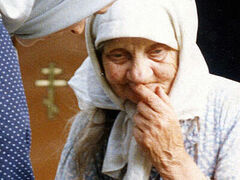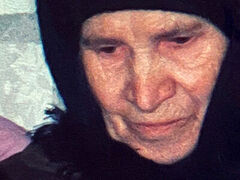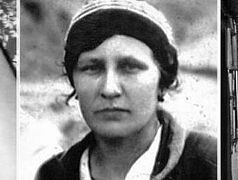On May 14, 2014, Russia’s beloved eldress, Mother Theodosia of Skopin, blessedly reposed in the Lord. Mother Theodosia was known throughout Russia and beyond; besides the many faithful Christians, monks, priests, hieromonks, and even bishops would visit her humble cell for spiritual counsel.
The following brief Life was translated from the Russian website dedicated to her memory.
Mother Theodosia was born in 1922, and she considered her birthday to be November 4, the feast of the Kazan Icon of the Mother of God, in the village of Velemya, Skopin district, Ryazan region. Her name was Natasha. She was a simple girl—modest and kind. Her family was poor and worked in the countryside.
One day, an accident occurred at work, and Natasha fell ill. Later, there was another accident, in which the tailgate of a truck fell on her—directly on her head. At the time she was thirty-three years old. The official medical diagnosis was: “brain concussion.”
Before all of this happened, Natasha had a dream in which a woman approached her and said, “Do not marry! You will be covered in flowers!”
After the accident, Natasha lay in the hospital. Her sisters wept over her. One day, an old man appeared to them—later revealed to be St. Nicholas the Wonderworker—and said, “Do not cry! Many people will come to you. You will not be alone.”
Natasha suffered terrible headaches; she cried and screamed from the pain. She was taken to Ryazan, where she was given disability status. Later, in a state of unconsciousness, she was placed in a psycho-neurological hospital. Natasha begged to be taken out of there, because they were giving her injections, which made her feel much worse. Soon her sister Olga took her home.
The illness caused by the head trauma continued to develop, and she was diagnosed with traumatic encephalopathy with personality changes. She was assigned to the first group of disability. Soon, Mother fell into a coma—not for a day or two, but for nearly fourteen years.
Mother Theodosia awoke from the coma on Pascha, April 18, 1971. On the Feast of the Ascension, May 27, she opened her eyes. It took her a long time to adjust to her new state. Her eyes were not always open. The first word she spoke was “mama.” Her coma had lasted from the autumn of 1957; that is, about thirteen years and five months. When she awoke, she was exactly forty-eight years old.
Mother Theodosia did not age as she slept in her coma. To the astonishment of many, she suddenly knew the entire Gospel, the Psalter, prayers, and akathists, though she had been completely illiterate.
Mother later said, “When my eyes opened, they were filled with blood. They put drops in them. My eyes began to clear, and I finally saw light. And then I began to see.”
While she slept in her coma, they fed her with a bottle and a spoon. Whether she was full or not, no one knew. When she woke up, she said: “I was full, the Mother of God fed me. Don’t worry about me, my joy! And I heard everything while I was asleep—even the flies that bit me! And in that other world, they read and sang, and I repeated after them. That’s how I learned! I must serve God!” Most often, Mother spoke in parables and revealed things differently each time.
 She did not say much about how she slept or where she had been during that time, but once she said: “There was one woman who slept and slept... Slept a whole week. They led her around the next world, showed her everything. Not only where the dead were, but also where the living would end up. And then they told her, ‘Tell no one what you saw.’” Mother Theodosia said, “The Lord has prepared everything for us—it all exists, both heaven and hell—and we will answer for everything!”
She did not say much about how she slept or where she had been during that time, but once she said: “There was one woman who slept and slept... Slept a whole week. They led her around the next world, showed her everything. Not only where the dead were, but also where the living would end up. And then they told her, ‘Tell no one what you saw.’” Mother Theodosia said, “The Lord has prepared everything for us—it all exists, both heaven and hell—and we will answer for everything!”
One day, Mother Theodosia shared something for our encouragement. She had grown weary of lying in bed—it was hard for her. And she began to weep. “Lord, I’m so tired! Take me!” She wept for a long time… She said that the roof of the had house disappeared, the sky opened, and an Angel appeared. The Angel placed a book on the table, opened it, and said, “Read!” “I read it and was at peace,” she said, “and the vision vanished. It was the book of my life. That was when I found humility.”
People often tenderly called Mother Theodosia, “Our Little Sun!” She radiated light, though she bore a burden beyond what most people today could endure—she was completely paralyzed and dependent on those who cared for her.
Pelagea, who looked after her, would often beat her, leave her unfed, and keep people from visiting. And what humility Mother had! She never once complained. On the contrary, she even felt sorry Pelagea. It is nearly beyond our comprehension.
To one woman, Mother Theodosia revealed something extraordinary: Upon entering the cell, the woman saw all the icons come alive—all the saints were moving, and Mother was speaking with them. Mother said to her, “Tell no one what you saw!” She also used to say, “I’ve been ready to go for a long time, but you won’t let me—you keep praying for me!”
For the sake of Mother Theodosia, her sister Olga gave up her own life, sacrificing everything. Her love for her disabled sisters (including her other sister Anna) was greater than her love for the man who had wanted to marry her. Olga carried this sacrifice to the end of her life. Mother loved her sister dearly and said she survived thanks to her. Doctors came from Moscow in order to diagnose her unusual condition, and they asked to take her to an institute for study, but her sister answered firmly, “As long as I’m alive, I will never give Natasha away!”
When Olga died, Mother Theodosia grieved deeply. She wept so bitterly that the bed itself trembled under her.
Mother also wept bitterly when she was slandered on the NTV show Maximum. They compared her to a fortune teller, a soothsayer, and Vanga.1 They had sent local drunkards to her cell with a hidden camera. Mother’s spiritual children wrote a letter to the President of Russia about the incident, and the show was shut down not long afterwards.
“It would be nothing terrible if I die while receiving people. That is why I live, and I will go on receiving them as long as I live.”
Even when her blood pressure rose to 300, she would keep receiving visitors, saying, “No! I must receive everyone! I must serve God!”
The love that radiated from Mother Theodosia was so all-embracing that sometimes people would simply come in and weep. They would leave, and everything in their life would be set aright. Without a word. The same still happens now, at her little chapel where she is buried. The feeling of love is so palpable that you hardly know whether you are on earth or in heaven.
She lay in her bed for over forty years, endured everything, received everyone with humility, and prayed unceasingly in the village of Oktyabrsky in the city of Skopin, Ryazan Province.
There were times when people saw the Mother of God enter Mother’s cell—even though all the doors were shut. Later, Mother confirmed these appearances.
Her counsel was simple, and her speech was homey. She would say, “It’s better to sing than to despair!” That’s why she even composed poems and songs. But the notebook in which her spiritual children recorded them has yet to be found. To those refused to listen to her advice, she would simply say, “As you wish! As you like!”
Mother Theodosia would give everyone chocolates as a blessing. And to this day her spiritual children bring chocolates to her cell, and others take them away as a blessing from her and for consolation. She would also offer tea and food. That is why tables stand next to her chapel even now, and on commemorative days, everyone—absolutely everyone—is treated to pies with tea and compote and various sweets.
While she was alive, Mother often asked everyone keep peace amongst themselves. This was her principal commandment to all her spiritual children. And of course, she told them to go to confession and receive Communion more often, to attend church. She could not understand how anyone could fail to go to church on a Sunday. “There are busses running, and people even have their own cars, so why don’t they go to church?” she would say.
“Well, I will die, I won’t be here with you forever. But don’t be troubled—I will still pray for you there!”
Once, Zinaida Zhdanova came to visit Mother. Zinaida had looked after the Holy Blessed Matrona of Moscow. People said to her, “How blessed you are to have known Matronushka!” Zinaida answered, “But how blessed you are—you have Mother Theodosia! She’s another Matrona!”
Mother Theodosia once said: “Be patient! Be patient! Even if fire burns me—I will be patient! Temptation? Endure it with all your strength! Don’t worry! Don’t quarrel! Just say, ‘Lord, give me strength.’”
“You see how many years I’ve lain here—and I smile. So you too, endure just a little!”
“How the Mother of God weeps! And I weep with Her! She came and said that women should not wear trousers—they offend Her terribly!”
“What a pure and blessed land this Ryazan soil is! So many saints were born here!”
“Be united in times of trouble—all of you! Keep peace! And remember: Come to my grave, ask, and I will always help you. I will never forsake you, I won’t forsake anyone. Remember that! Whoever remembers me and calls upon me after my death, I will come to help them.”
Mother Theodosia remained immobile until her very repose. She fell asleep in the Lord on May 15, 2014, still receiving people even on the eve of her approaching death. That morning, she received Holy Communion, and then peacefully departed unto the Lord.
When they buried her it was as if all of Russia had come to mourn. People traveled from abroad, from every corner of the earth. Simple folk and clergy came: metropolitans, bishops, along with pilgrims, schemamonks, fools-for-Christ, and elders. They all came to bid farewell to Mother. The small provincial town of Skopin had never seen such a multitude in all its history. People walked on foot for nine kilometers behind the car carrying the coffin with Mother Theodosia’s body. When they carried her out of the church, they sang, “Christ is Risen!” A breeze lifted the edge of her monastic schema,2 and then many saw a smile appear on Mother’s face.
Her grave became a place of unceasing pilgrimage. At the initiative of those devoted to her, a plot of land was purchased near the Velemya cemetery for the construction of a church in honor of the Kazan Icon of the Mother of God. Construction of that church is now underway.
When Mother said she wished to be buried in Velemya, many could not understand why, since the cemetery was nearly abandoned. Her sister Olga told her, “Mother, no one will ever come there!” But Mother replied, “They will come. And how they will come!”
And truly, after her burial, within a year, the cemetery was transformed. Many people started taking better care of their relatives’ graves. Today, the cemetery is unrecognizable compared to what it once was. In 2019, the authorities built a new asphalt road from Skopin all the way to Velemya. Mother’s prophecies were fulfilled with remarkable precision.
“I will die when the orchards are in bloom,” she once said. “You will celebrate Pascha with joy, but bid me farewell with tears. My joy, do not weep—everything will be well! The Lord loves those who are patient! You will come to me, and I will come to you as a little bird. When you see a bird, know that it’s me. Tell me everything, and I will help you.”
“I no longer feel any pain! If you only knew how my soul longs to be united with the Lord! And the Lord hears me. Where there is peace, there is the grace of God. I pity people—they are like blind kittens, not knowing where to go. But one has to walk through life! Do not give up! Why despair? One has to live! We were cold, we were hungry, but we lived joyfully—we walked singing songs, even barefoot. Most importantly—do not offend anyone! My children, do not offend anyone! One must be patient! Above all, stay with the Lord! With God!”
Mother was spiritually present in many places and would talk about unusual things that would later be confirmed. One could speak endlessly about Mother Theodosia—her greatness and her ascetic labor. She received people throughout the night, prayed during the day, and barely slept at all. She lay motionless for fifty-seven years, and lived to be 92. She was known throughout all Russia, on Mount Athos, across the former Soviet Union, and in many other countries. She had spiritual connection with Archimandrite Pavel Gruzdev, Elder Kirill (Pavlov), and many, many others.
Testimony to her sanctity can found in the manner of her departure—and in the ceaseless flow of pilgrims to her grave. For, as the saying goes: “No one draws water from an empty well.”
Schemamonk Theodosia is buried in the village of Velemya, Skopin district, Ryazan region.
Mother Theodosia, pray to God for us!








